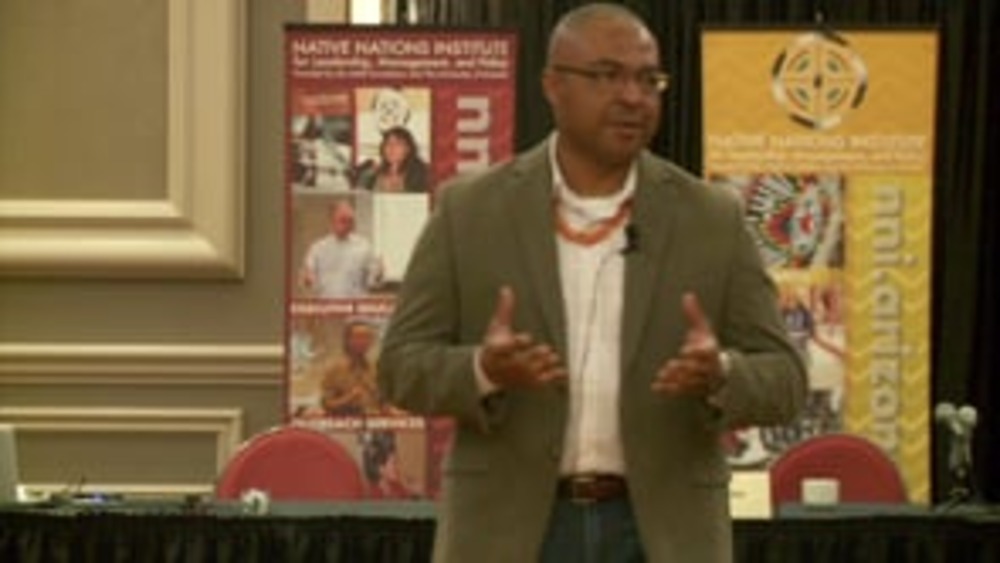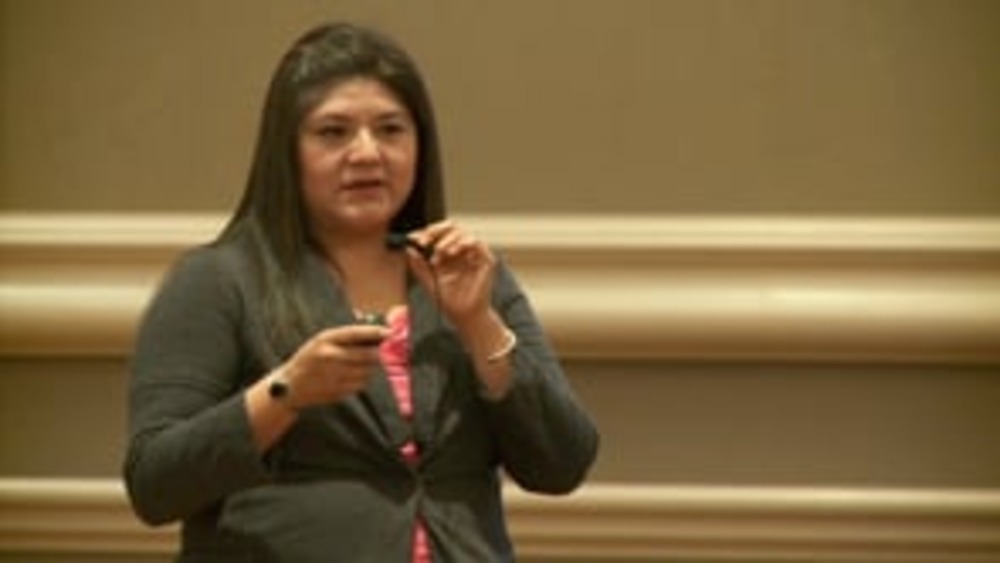NNI Research Director Miriam Jorgensen concludes the 2004 Honoring Nations symposium with her impressions about the lessons learned from the convening, from the great diversity among Native nations to the great strides they are taking when they devise their own solutions to the challenges they face.
Additional Information
Jorgensen, Miriam. "Lessons to Take Home." Honoring Nations symposium. Harvard Project on American Indian Economic Development, John F. Kennedy School of Government, Harvard University. Cambridge, Massachusetts. September 10, 2004. Presentation.
Transcript
"I just want to say thank you to the previous speaker because he really...it's Rick George? I'm sorry, I was busily writing down all your notes and the name was like the thing up ahead. You just did a fantastic job of making a lot of the same kinds of summary points that I'd like to make. Even though you were thinking ahead to the future about how to continue on the success of programs, I just hope that everyone was really taking to heart a lot of the things that he was talking about, because they really scored deeply in my mind as things that were very important. So in a sense, I kind of feel like I'm kind of adding to your list or underscoring some of the same things that you were saying. I was asked to draw together some lessons that we've heard at this symposium and also to offer some more reflections, just to try to put a tie up on things.
And I think we all have probably some different ideas about what we've learned, the thing that we're walking away with that touched us the most, but I just wanted to start off with this observation. Boy, tribes are solving really tough problems, aren't they? These are not sort of little easy things that your programs are addressing, not little administrative fixes, not little 'let's take this small program and do this little change and things are going to be done.' You're addressing problems that are as big as the rights of Native people incarcerated in local, state and federal prison; preserving the rights of American Indians and Native nations to have the say over how remains are appropriately treated and reburied; the right to control land and water and other natural resources in ways that make sense. The programs that address really tough problems like children's safety, family violence, and problems that are very overarching, but hit at the core of what Native sovereignty means, like control over whether or not you get to run your own law enforcement department, because what more fundamental right is there in tribal government than to be the one that controls, who wields coercive force within your society? Should that be the federal government? No. And tribes are...and we've honored a program, the Gila River Police Department that took that on, that task. So these are tough problems.
And that leads me to one of the big lessons that I think comes out of what we've learned today: that in addressing these tough problems, there's clearly a lot that we can learn from each other. There are ways to figure out the way through the administrative maze of working with state departments or with the federal government or even going up to the international level when that's necessary. Things we can learn from each other about those administrative fixes or about particular strategies that apply sometimes across programs of different sorts, or when we have programs that are very similar to each other, there are definitely things to learn from each other. But there's also a sort of a parentheses at the end of that, and that's the notion that if you look around this room there's also tremendous diversity. And I think that's kind of the notion of saying, 'Yeah, we can learn a lot from each other, but sometimes what we learn from each other is how different we still are.'
I think there's this thing...and I do a lot of teaching about Native America to non-Natives and of course others have said this before, that one of the things that's the first reaction is, ‘Oh, my gosh! You mean there are still a lot of Native people in the United States?' And after that they say, ‘And of course they're all the same, right?' And you look around this room and say, ‘No, we're not.' We come from very different cultural traditions. We come from very different practices, very different histories. Some tribes have the Trail of Tears, others had no removal; some had no major battles, some had lots, some have a very modern history of struggle and fight. There's just a lot of differences out there, and I think in learning from each other about our programs, it's also acknowledging that difference and saying, ‘You do it that way and that's helping me understand how our way is different and we need to be different as well.' So I think there's lessons in difference as well, as much as there is to learn from similarities and things we can do the same.
One of the other big points that I walk away with -- and all of you who have been close to the Harvard Project for years or just learning about the Harvard Project may think that this is just one of the things that we trumpet all the time, but in hearing conferences and symposia like this, I think that we're getting it right: that you can't ever abandon this notion that tribal sovereignty, the sovereignty of Native nations and the issues of self-determination and self-governance just stand above all in a lot of these programs. And you can just hear it in the strains of how important that is in the way the programs are implemented and the actions that the leaders are taking to make those programs work.
But I think another...and a reflection and something I've heard in listening to the breakouts and listening to the speakers is that the notion that that battle for sovereignty just never ends. And I think it was somebody yesterday who talked about being wary of complacency, that you may feel like you've gotten to a point where things are successful or that battle is won, but I'm reflecting on something that the gentleman Edward [Wemytewa], whose last name I'm not going to pronounce correctly, who's the Zuni Eagle Sanctuary representative said to us, ‘You know, we have to fight that battle all the time because the personnel change and sometimes memories are short. Even our own memories change and we have to keep at the forefront what our battle is for -- it's for our rights and our sovereignty,' and that's just something that keeps going as a lesson throughout as well.
Sort of a sub-piece of that, and this again is to tie into what Rick George said, is that one of the very important pieces, and kind of picking up on what, you know, the reactions I heard to Myron's [Brown] talk yesterday and some of the things that Greg Mendoza said this morning, is that one of the ways to keep fighting that battle is to really train the youth, be they on-reservation youth, off-reservation youth, folks who are really engaged or folks who are not yet engaged, is to teach them about tribal government, about the rights of American Indian people, and to have them be ready to hold that banner forward as well.
The next point -- and this is just a quick one because it's already been covered well by Mr. George -- this is the one where I was thinking, ‘Hey, this is exactly what I was going to say,' is the notion of leadership. Julie Wilson talked about this this morning a little bit, how she said there's leadership in every place. She said that was what struck her, somebody coming from the outside, looking at Indian Country, not thinking about it very much before, is how the leadership of the Honoring Nations programs emerged from lots of different places. When we think about the safety program that the Mississippi Choctaw have put together, one of the things there is that this emerged from just activists, community activists. It's the same with a program we honored several years ago, the White Earth suicide intervention program. These are not people who are already engaged in tribal government, but activists that bubbled up from within the community. Other times it's a tribal bureaucrat who says things can operate differently or somebody like Greg who was out of government, just a youth who said, ‘We need to change the system.' So leadership is everywhere and honoring that, reacting to it, providing a means for them to move forward is just an important piece too.
The last thing I want to say, and if anything this is the thing that I felt this symposium did really well and that Amy [Besaw Medford] really needs to be honored for and those who really worked with her on that, is that one of our goals in all of this is to create an environment where we can learn from each other and I think that happened. I think that this has been a place where, and I'm going to use a really sort of Harvard Business School kind of word I guess, the 'network' word, but I think we've done more than network. I think what we've done is expanded our circle of friends. Manley Begay earlier in the day was saying to me, I said, 'how do you like those sessions, Manley?' And maybe I'm telling tales out of school, but he said, ‘I've just been having trouble getting to the sessions, Miriam, because I've just been talking to so many really interesting people about great programs and learning a lot about them and expanding our teaching skills and thinking about stuff that we ought to be looking into and making more friends and renewing old friendships.' And I said, ‘Manley, I know what you mean.' And I walked away from that and I kept looking around going people are really engaging with each other. If they didn't know each other before, they're introducing themselves to each other, they're renewing old friendships and they're even getting together with their group that they came with and said, ‘Oh, I just talked to so and so and I learned about this.' That is great. That's what we wanted to do. And that, I think, is more than networking because networking to me kind of implies I'm going to get out my pack of business cards and I'm going to hand it out to people because I'm going to say to them, ‘What are you going to do for me? Are you going to get me a job? Are you going to get me a connection?' But this is networking among friends. It's expanding that circle of friends so that when we walk out of here we know lots of people who do very interesting things that can help us and the tribal communities that you work with certainly, but there are also support systems and colleagues and people to share joys with -- people who care about us personally, about our professional careers, and about the Native nations that you serve. And I think to that extent this symposium has been very successful and helpful and something that I'll definitely remember.
So those are the lessons and reflections that I offer and I just want to send you off with that spirit of positiveness and hope that you've gotten that joy out of this symposium like I have."



